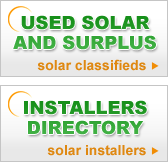
|
Solar Energy is the Wave of Future for HomeownersTim
Carter - Pamela D.,
Solar energy makes sense for a number of reasons. Natural resources such as oil, coal and natural gas are being used faster than geologic processes can create them. Meanwhile, the sun's energy output is constant, or nearly so, every day. When the sun is shining on south-facing lots in the Northern Hemisphere, huge amounts of energy can be captured. In fact, you might capture excess energy that can be sent backward through the power lines to neighboring houses. My friends in Colorado routinely do this with their solar-energy system. There have been significant advancements in solar-energy technology. The biggest may be the consistently decreasing costs for photovoltaic cells and panels and other equipment. Although solar energy is still pricey, these lower costs translate to faster paybacks, which increase the likelihood of a positive return on investment while you still own the house. There are different residential active-solar-energy systems. One uses photovoltaic panels and cells to transform sunlight into electricity by a natural process common to certain crystals. If extra electricity is produced, it is stored in batteries. If the batteries get fully charged, you can send the electricity back downstream into the electric company power grid, if you have permission. Another solar-energy system captures radiant heat from the sun. You can use this heat to raise the temperature of air or water in your home. A solar-energy water-heating system that uses the sun's radiant heat can be an open or closed loop. An open-loop system takes the actual water that will be used and sends it to the solar-heating device. This system works best in areas where freezing temperatures don't occur. An open-loop system could freeze up in the dead of winter on a bitter cold night. Closed-loop systems contain a liquid in the piping system that will not freeze. The sun heats this liquid, and the heat is transferred to the domestic water-supply lines via a simplistic heat exchanger. I intend to use one of these closed-loop systems in a home I am planning to build in New Hampshire. I also intend to install a photovoltaic system to help lower my dependence on the electrical grid. Smart architecture also can help capture solar energy. Passive solar energy allows you to capture the strong solar rays that can heat up interior surfaces in your home during daylight hours. Dark natural-stone flooring or other dense materials that can absorb solar heat work very well. As the sun sets, these heat repositories then slowly release the stored energy back into your home. Mother Nature gives freely of her solar energy, so be sure not to waste that which comes your way. Some solar-energy systems need periodic maintenance. The solar panels
may have to be cleaned regularly to ensure peak performance. The tilt
of certain panels may have to be adjusted several times a year to get
the maximum benefit from the sun's rays. You also may have to check
batteries to ensure you have power when the sun is not shining.
 |






